VitalTrak vs Concierge Medicine Services

Understanding the Evolution of Modern Healthcare Options
The landscape of healthcare is rapidly evolving, driven by innovative membership-based services and digital health solutions designed to offer more personalized, accessible, and efficient care. This article compares VitalTrak’s cutting-edge digital health management approach with traditional concierge medicine services, exploring their features, benefits, and implications for patients and providers alike.
The Rise of Membership-Based Healthcare
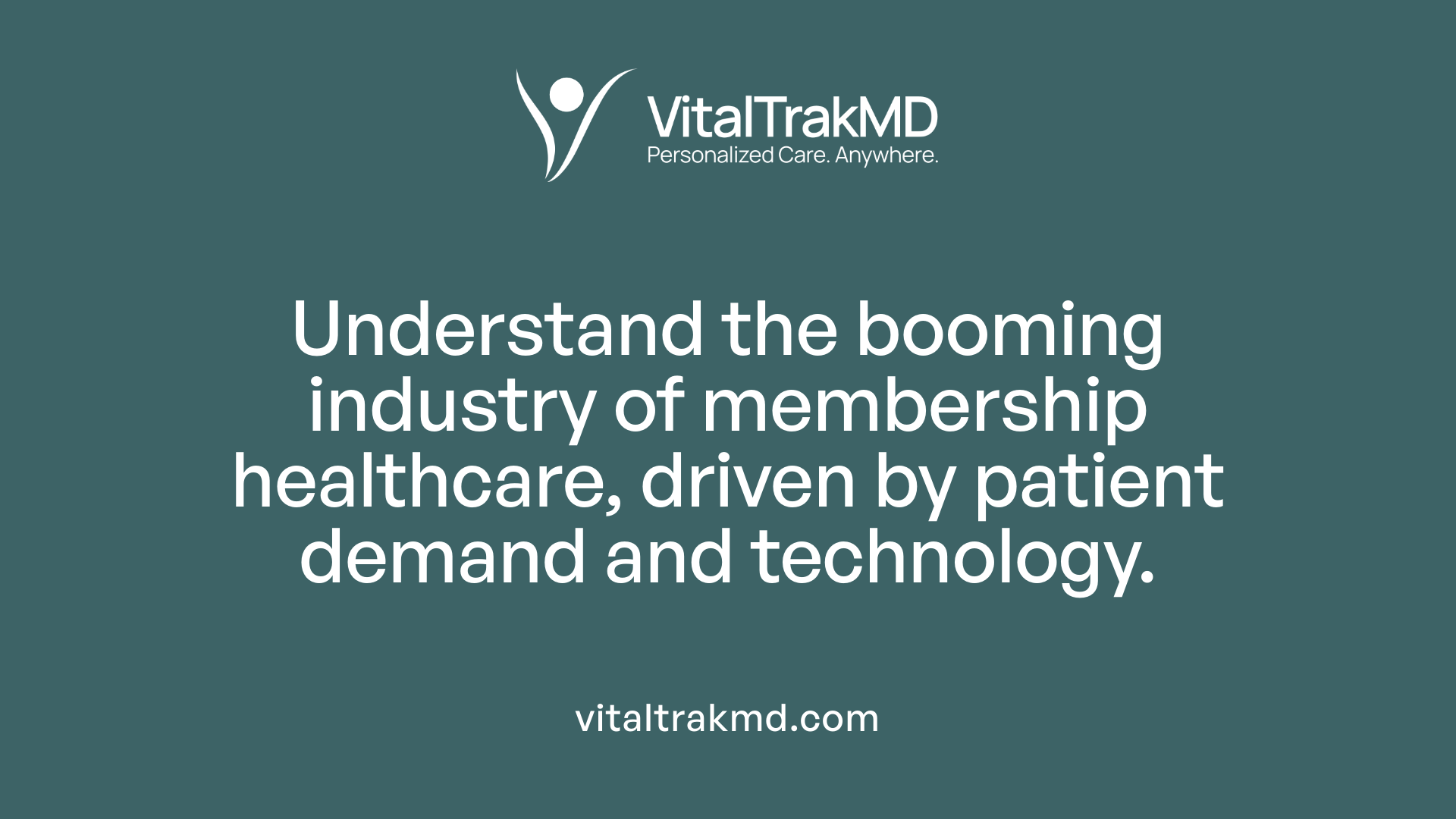
What are direct primary care (DPC) and concierge medicine models?
Direct primary care (DPC) is a healthcare approach where patients pay a regular membership fee directly to their doctor, in exchange for comprehensive primary care services. This model skips insurance billing entirely, offering convenience, transparency, and personalized attention. Patients often enjoy same- or next-day appointments, telehealth options, and routine preventive services.
Concierge medicine, on the other hand, involves an annual or monthly membership fee that grants enhanced access to physicians. Members typically pay between $2,000 and $10,000 or more annually, plus additional costs like co-pays for certain services. Concierge practices often include amenities such as extended visits, 24/7 direct communication, and specialized diagnostics.
While both models emphasize personalized, accessible care, DPC tends to be more affordable and straightforward, focusing on routine primary care. Concierge medicine often offers a broader scope, including specialized and advanced procedures.
How is the industry growing?
The membership-based healthcare industry is expanding rapidly. Currently, an estimated 10,000 to 25,000 physicians in the U.S. and abroad practice within these models.
In terms of financial worth, the industry was valued at around $5.5 billion in 2021. Projections suggest it could reach approximately $13.3 billion by 2030, reflecting strong growth driven by patient demand for personalized, accessible care.
What are the costs and who are the typical patients?
DPC practices usually charge lower monthly rates, making them more accessible for middle-income individuals. For example, Family Tree Primary Care offers transparent monthly fees: $35 for children, $75 for adults aged 19–44, $95 for ages 45–64, and $115 for seniors over 65. They also provide a family plan at $240 per month.
Concierge medicine fees generally range higher, from around $1,200 to $50,000 annually, often targeting wealthier patients seeking premium services and extensive access.
Patients most suited to DPC are generally younger or middle-income individuals seeking straightforward, personable primary care without the complexities of insurance. Concierge patients tend to be wealthier, often prioritizing convenience, immediate access, and comprehensive wellness services.
| Model | Typical Fee Range | Main Focus | Patient Profile | Additional Services |
|---|---|---|---|---|
| Direct Primary Care | $600 - $1,500 per year | Primary care, preventive services | Middle-income, younger adults | Same-day/next-day visits, telehealth |
| Concierge Medicine | $2,000 - $10,000+ annually | Personalized, expanded healthcare access | Wealthier, prioritized care | Same-day appointments, diagnostics, 24/7 access |
Both models aim to simplify healthcare costs and improve patient experiences by focusing on quality, accessibility, and reducing administrative burdens.
Financial Aspects: Costs and Access in Different Models
What are the membership fees for DPC and concierge services?
Direct Primary Care (DPC) practices typically charge lower monthly fees, often ranging from $35 for children up to $115 for seniors aged 65 and older, with family plans available around $240 per month. These fees usually cover routine primary care services, preventive care, and quick access to physicians.
In contrast, concierge medicine involves higher annual or monthly fees, usually between $2,000 and over $10,000. Some elite practices may charge upwards of $50,000 per year, especially if they include extensive personalized services.
| Service Model | Typical Fee Range | Coverage Details | Additional Costs |
|---|---|---|---|
| DPC | $35–$115/month for individuals, $240 family plan | Basic primary care, preventive services, same-day or next-day appointments | Does not usually cover hospital stays, surgeries, or specialty care |
| Concierge | $1,200–$50,000/year | Personalized care, advanced diagnostics, expanded access | Co-pays, deductibles for additional services and specialized treatments |
How do insurance billing practices impact costs?
DPC practices avoid insurance billing altogether, focusing on membership fees to streamline services and reduce administrative costs. This often makes healthcare more predictable and affordable for patients without insurance or those seeking straightforward primary care.
Concierge medicine, on the other hand, may bill insurance for services outside the membership package, such as specialist referrals or diagnostic tests. However, practices are careful not to double bill for services included in the membership, as this could be considered fraud.
While insurance plans offered through platforms like Healthcare.gov typically cover hospital stays, surgeries, prescription drugs, and preventive screenings, they often involve co-pays and deductibles that can add up, especially for individuals with ongoing health needs.
Accessibility and patient demographics
DPC practices tend to attract younger, middle-income patients seeking personalized, accessible primary care without dealing with insurance complexities. These patients usually desire quick appointments, telehealth options, and straightforward billing.
Concierge services are generally aimed at wealthier individuals who can afford substantial ongoing membership fees for enhanced access. They often include 24/7 direct communication with physicians and comprehensive wellness services.
| Model | Typical Patient Demographic | Access Features | Cost Transparency |
|---|---|---|---|
| DPC | Middle-income, younger adults | Same-day/next-day visits, telehealth | Clear, fixed monthly rates |
| Concierge | Affluent, older adults | 24/7 direct contact, extensive personalized care | Premium pricing, often higher, but transparent |
What criticisms exist regarding concierge medicine?
Critics argue that concierge medicine benefits primarily the wealthy. Patients pay significant fees—often ranging from $1,500 to over $20,000 annually—for luxury services. This model risks creating a two-tier healthcare system, where access and quality of care are dictated by financial capacity rather than medical need.
Such disparities could lead to greater healthcare inequities, as those unable to afford concierge services might face longer wait times and less personalized care. The high costs and lack of regulation may further contribute to ethical concerns about fairness and justice in healthcare.
| Criticism Area | Main Concerns | Impact on Healthcare System |
|---|---|---|
| Access Disparities | Benefits only the wealthy; risks creating a tiered system | Exacerbates inequality across socioeconomic groups |
| Ethical Issues | Potential neglect of low-income and uninsured patients | Undermines principles of fairness and universal health coverage |
| Regulatory Gaps | Lack of oversight on billing practices | Raises risks of fraud and abuse |
Understanding these financial differences helps illuminate how varying healthcare models affect patient access, affordability, and the overall fairness of healthcare services.
Comparative Patient Experience and Service Accessibility
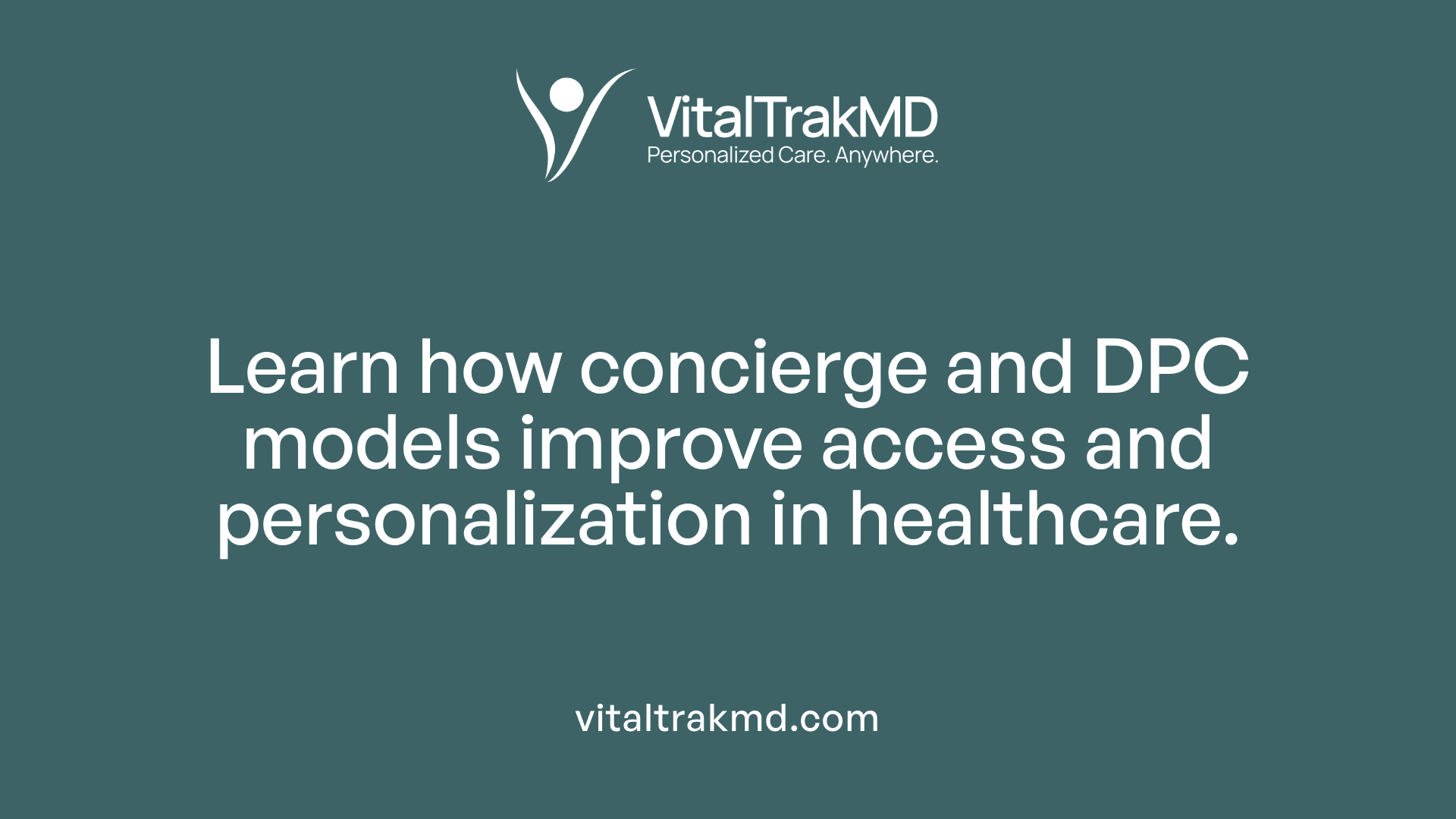
How does concierge medicine compare to other healthcare options?
Concierge medicine and Direct Primary Care (DPC) both focus on offering more personalized healthcare experiences. Patients in these models usually benefit from longer, more thorough appointments and quicker access to their doctors compared to traditional healthcare. DPC practices typically charge a lower monthly fee, often ranging from $600 to $1,500 per year, and exclude insurance billing, which simplifies the process and reduces costs.
Concierge medicine generally involves higher fees—ranging from about $1,200 to $50,000 annually—and includes extensive, sometimes 24/7, access to doctors. It also may bundle additional services like advanced diagnostics at higher costs. These features appeal more to wealthier patients seeking immediate attention and comprehensive care.
Traditional healthcare often relies on insurance, leading to longer wait times—averaging around 29 days for appointments—and less personalized attention. In contrast, both concierge and DPC models prioritize proactive, personalized care, with amenities such as same-day or next-day appointments, direct communication via calls or texts, and extended visit durations.
While these newer models improve the patient-doctor relationship and healthcare responsiveness, they also tend to restrict access for those unable to afford membership fees, raising concerns about healthcare equity. Overall, concierge medicine offers a premium experience with exceptional convenience, whereas DPC provides a more affordable, member-focused alternative for routine primary care.
Differentiating Features of VitalTrak and Traditional Concierge Services
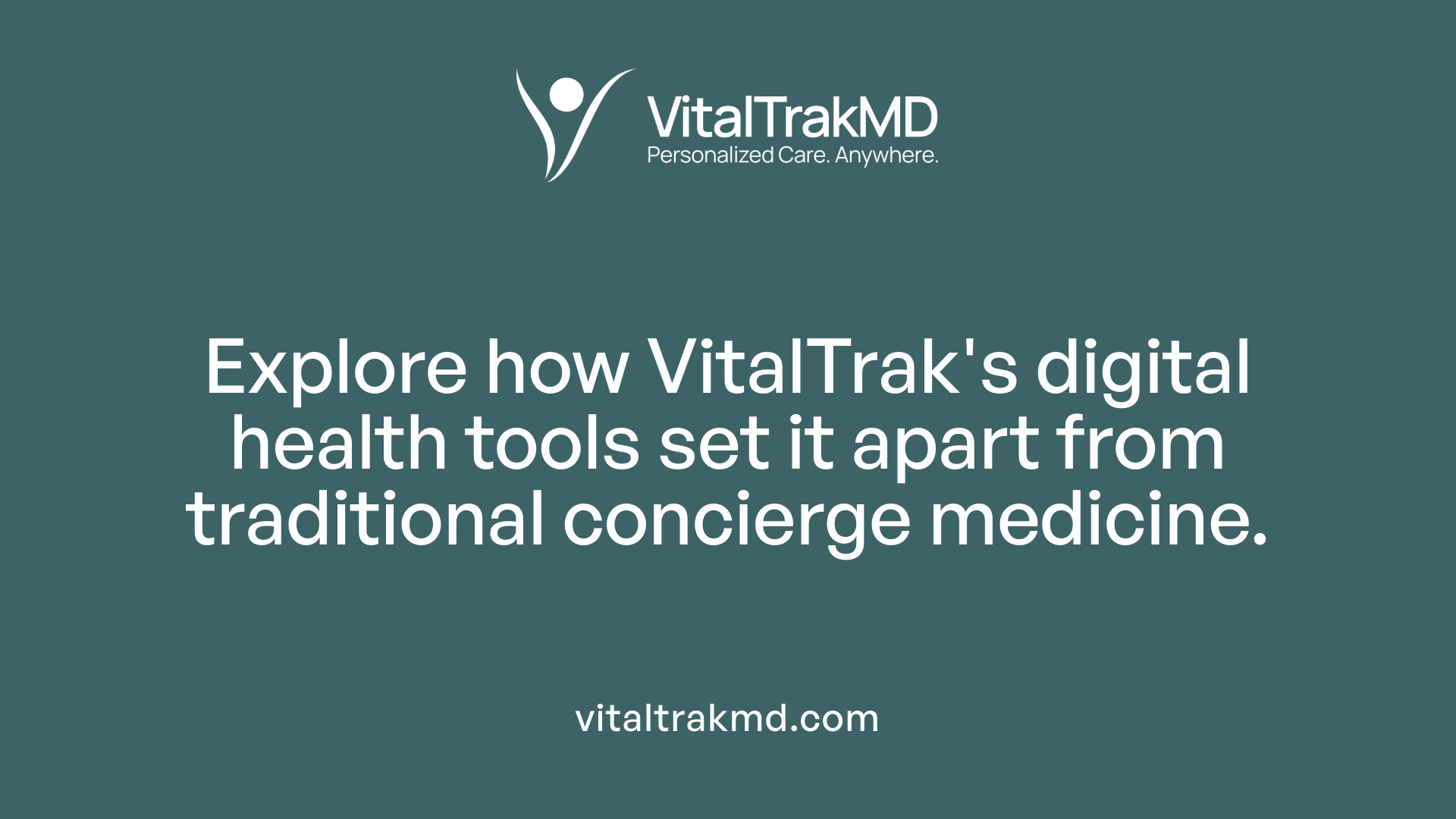
What features differentiate VitalTrak from concierge medicine services?
VitalTrak stands out from traditional concierge medicine by integrating advanced digital health technologies, making health management more personalized and proactive. Unlike standard concierge practices that primarily offer premium in-person or hybrid services for affluent patients, VitalTrak focuses heavily on digital health tracking and remote monitoring.
Through real-time data collection and analysis, VitalTrak enables patients and doctors to stay connected continuously, even outside of physical appointments. This approach allows for early detection of health issues and tailored preventive strategies.
Moreover, VitalTrak offers virtual care options, including telehealth consultations, which provide convenience and immediate access. Its suite of personalized health management tools helps track various health metrics, set goals, and receive data-driven insights, empowering patients to take an active role in their health.
While traditional concierge services may expand care with additional in-clinic or specialty access, VitalTrak’s key innovation is its use of digital solutions to extend and enhance the healthcare experience. This technological integration not only improves patient engagement but also supports a more efficient and preventive approach to health.
In summary, VitalTrak’s fusion of digital health tracking, remote monitoring, and personalized health tools represents an evolution beyond traditional concierge medicine, emphasizing continuous, data-informed healthcare management.
Physicians’ Motivation Behind Digital and Membership Models
Why are many physicians choosing concierge medicine?
Many physicians gravitate toward concierge medicine because it allows them to offer a more personalized level of care. Instead of handling large patient panels typical of traditional practices, they focus on fewer patients, enabling longer visits and more comprehensive attention.
This model often includes perks such as same-day or next-day appointments, direct communication through calls or texts, and specialized services like wellness counseling and advanced diagnostics. These features help doctors build stronger relationships, improve patient outcomes, and address individual health needs more effectively.
Another appeal of concierge medicine is the reduction in administrative burdens. Since much of the billing and insurance paperwork are eliminated, physicians spend more time with patients and less on paperwork. This streamlines the practice and decreases stress.
Many doctors also find that this approach helps prevent burnout. With smaller patient loads, their workloads are more manageable, leading to higher job satisfaction and better quality of care.
Furthermore, integrating technologies like telehealth and at-home care options makes practices more sustainable and flexible. These innovations support physicians in delivering efficient, patient-centered care, aligning with their motivation to practice medicine more meaningfully while enhancing practice stability.
Industry Trends and Future Outlook in Membership Healthcare
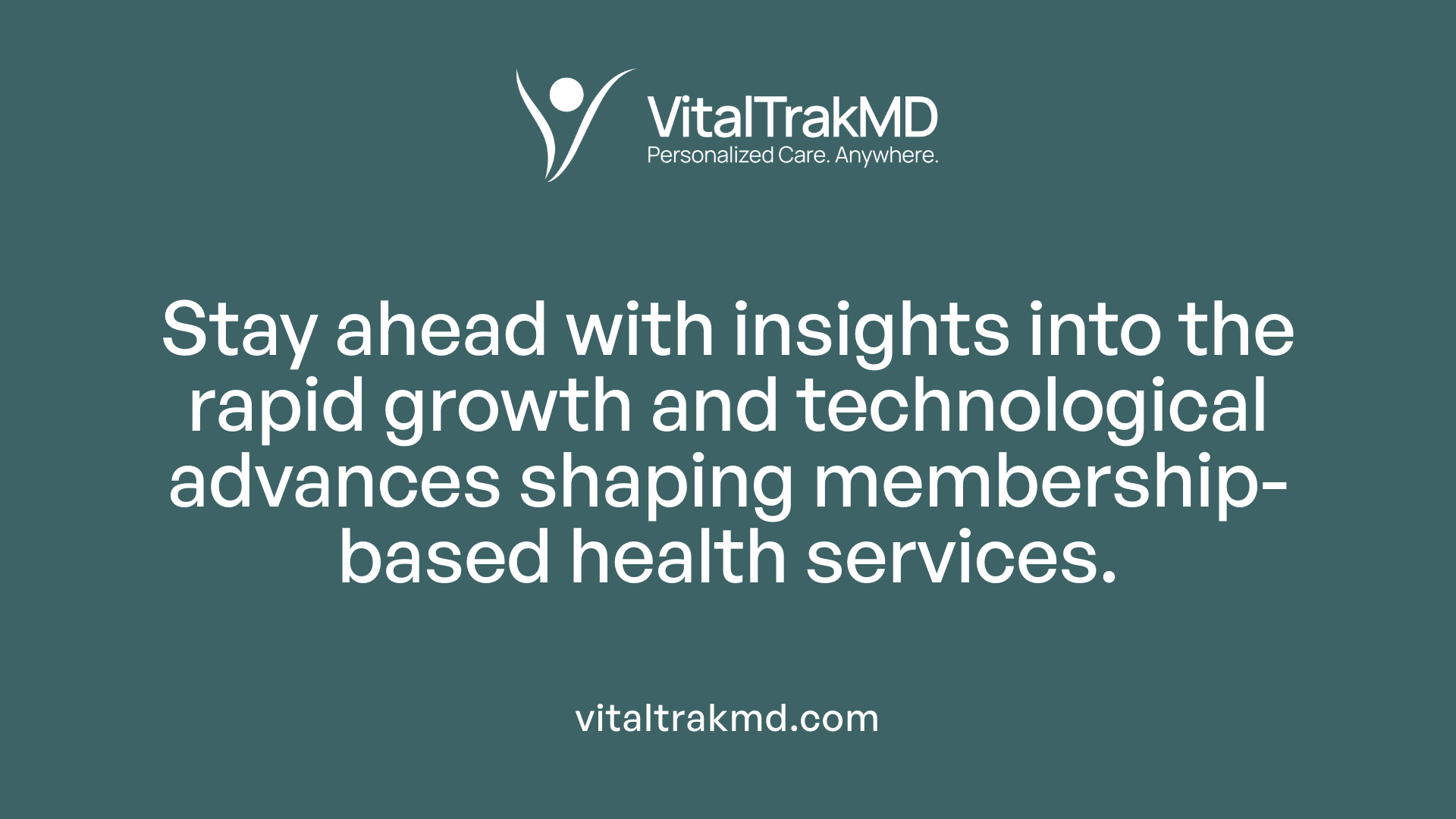 The membership healthcare sector is experiencing significant growth, with current estimates indicating that between 10,000 and 25,000 physicians in the United States and abroad have adopted these models. Valued at approximately $5.5 billion in 2021, this industry is projected to more than double by 2030, reaching around $13.3 billion.
The membership healthcare sector is experiencing significant growth, with current estimates indicating that between 10,000 and 25,000 physicians in the United States and abroad have adopted these models. Valued at approximately $5.5 billion in 2021, this industry is projected to more than double by 2030, reaching around $13.3 billion.
Technological advancements are playing a crucial role in shaping how membership-based healthcare services operate. Telemedicine, digital health records, and mobile health applications make accessibility easier for patients, allowing for same- or next-day appointments and continuous communication with providers. Tools that enable remote monitoring and at-home consultations align well with the personalized and immediate care that these models promote.
Looking ahead, the market for membership healthcare is expected to expand further. Increased patient demand for personalized attention, combined with a desire to avoid traditional insurance complexities, fuels this growth. Experts predict that innovations in digital health technology and broader acceptance of direct primary care and concierge services will drive continued market penetration.
While these models increasingly attract a diverse demographic—including middle-income families seeking affordable, high-quality primary care—they also raise questions about equitable access to healthcare. Nonetheless, their focus on proactive, patient-centered care positions them as key players in the evolving healthcare landscape.
| Aspect | Details | Additional Info |
|---|---|---|
| Industry size (2021) | $5.5 billion | Projected to reach $13.3 billion by 2030 |
| Physician adoption | 10,000–25,000 | Worldwide |
| Main growth drivers | Technology, patient demand | Digital health tools, convenience |
| Future directions | Increased market share | Digital integration, broader accessibility |
Conclusion: Navigating Future Healthcare Choices
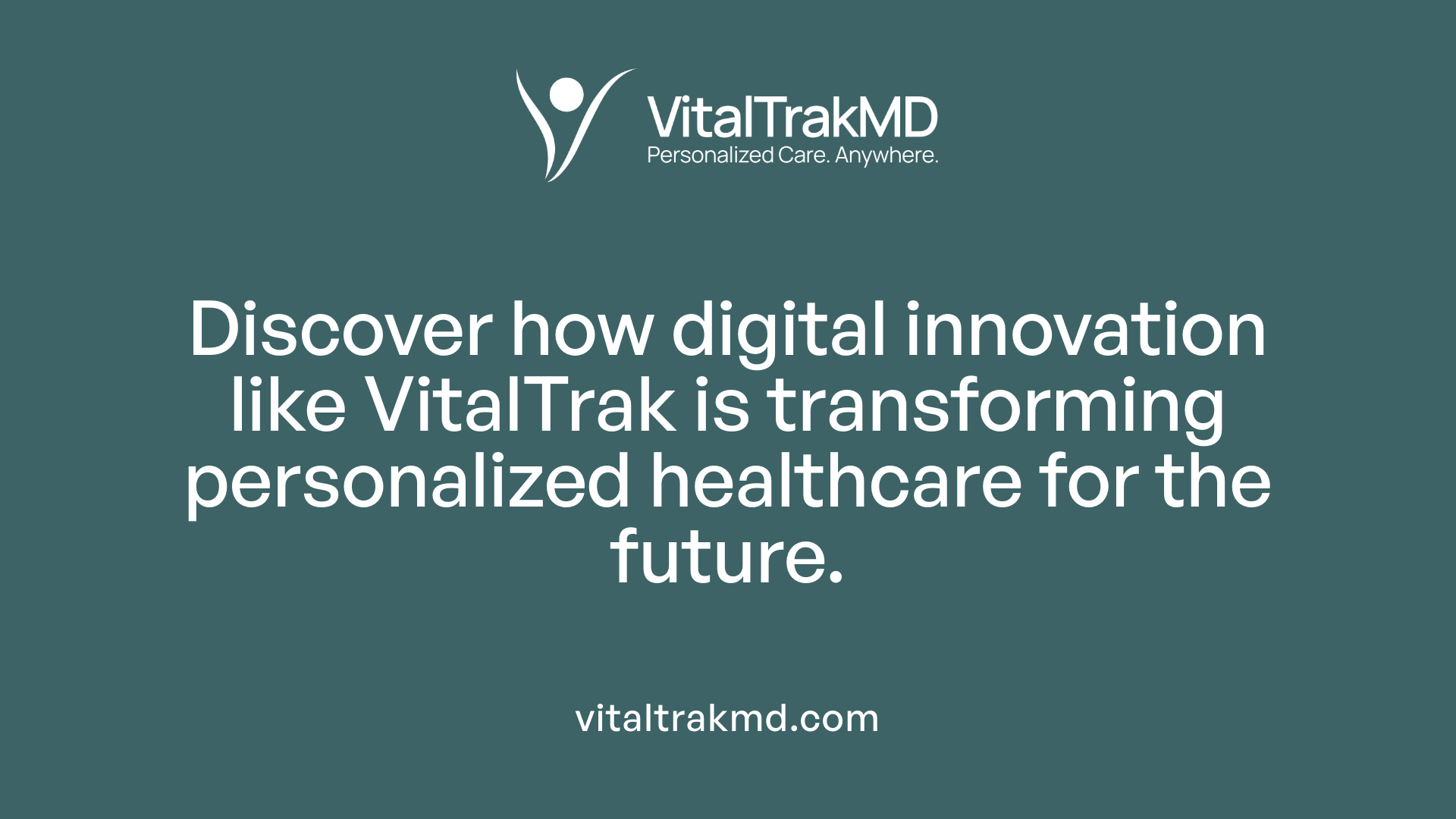
What features differentiate VitalTrak from concierge medicine services?
VitalTrak stands out from traditional concierge medicine through its focus on digital health technology and personalized management tools. While concierge services typically prioritize in-person and hybrid care, often catering to wealthier patients with advantages like same-day appointments and direct communication, VitalTrak emphasizes remote monitoring, virtual healthcare options, and real-time data analysis.
This modern approach allows for continuous health tracking and proactive disease prevention, making healthcare more accessible and tailored to individual needs. Unlike traditional concierge practices that may expand through additional specialized services or high-cost procedures, VitalTrak leverages innovative digital solutions to enhance health management.
Overall, the main distinction lies in VitalTrak’s use of advanced technology to foster more engaged, preventative, and efficient healthcare experiences beyond the conventional scope of concierge medicine. It offers a seamless blend of digital tools and personalized care, paving the way for a future where healthcare is more connected, data-driven, and accessible for all.
Choosing the Healthcare Model That Fits Your Needs
As healthcare continues to evolve, patients have more options than ever before. Digital health platforms like VitalTrak offer innovative, data-driven approaches to preventative and personalized care, while traditional and concierge models provide varying levels of in-person service, accessibility, and cost. Understanding the features, benefits, and limitations of each model is crucial for making informed healthcare decisions that align with individual needs, financial considerations, and health goals. Whether prioritizing cutting-edge technology or personalized human interaction, patients can now select a healthcare approach that best supports their well-being.
References
- Direct Primary Care Vs. Concierge Medicine: Key Differences
- Concierge Medicine vs. Traditional Healthcare: What's Right for You?
- Concierge Medicine vs. Traditional Health Insurance - Cover Kansas
- Medical Services in Encinitas, CA - Bruce J Sachs, MD
- Concierge Medicine Versus Direct Primary Care - Software Advice
- Why More Physicians Are Going Concierge. Should you?
- The Difference Between Direct Primary Care and Concierge Medicine
- Direct Primary Care Vs. Concierge Medicine: Key Differences
- A literature review on the impact of concierge medicine services on ...
Recent articles
Want to Feel Better and Live Healthier?
Join hundreds of patients taking control of their health with personalized care that fits their life – not the other way around.
Rated 4.8/5 by 32+ customers







